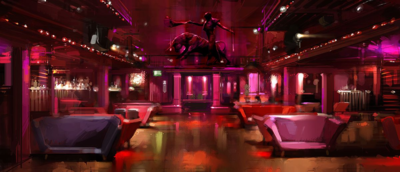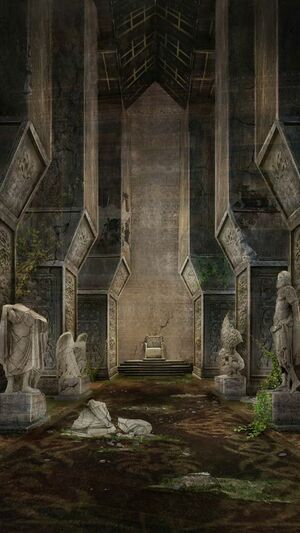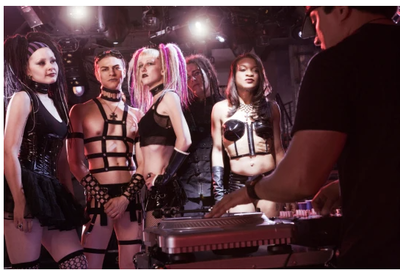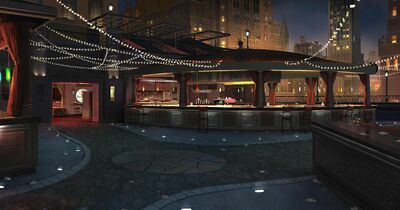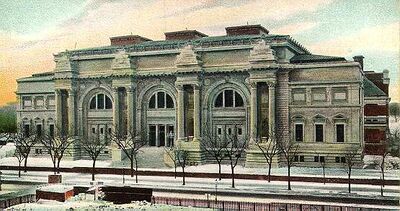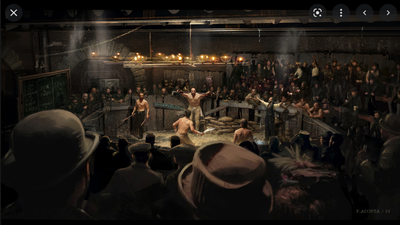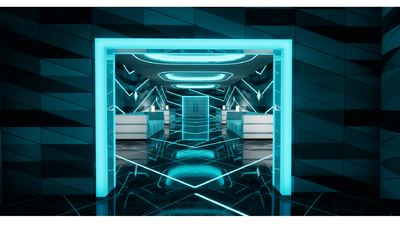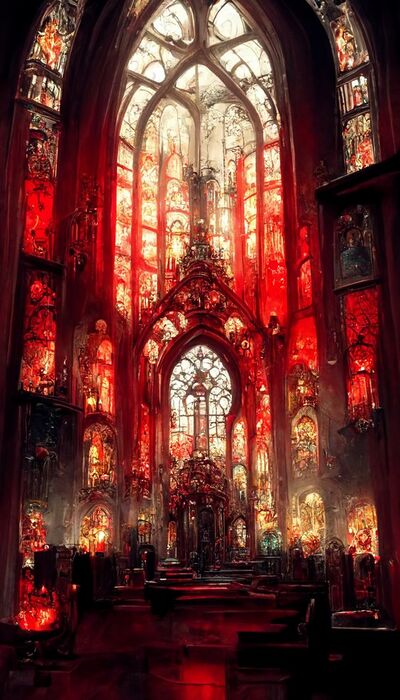Esbats
These are the known common Esbat Locations in New York City.
Club Ardor
Club Ardor is based in a white three story building with a black and red sign. A black carpet and red velvet ropes lead to the black double doors that are the entrance. The first floor is set up in typical club style, 2 bars, a dance floor and stage, seating and shadowy corners. A VIP section contains a staircase that leads to a second floor that can not be seen into from the lower section. The second floor can see down into the first, has a smaller dance area, more luxurious seating, bathrooms with larger stalls and seven locked doors.
Perhaps the most striking part of the club is that all who enter (Path dead or not) are granted the effects of life, they can eat and drink and feel the same sensations of pleasure or pain as a mortal does.
Temple of Caine
Every Sabbat city has a Temple to Caine, a place of worship and sanctuary for all sabbat, New York However has five. The history of the temples to caine in New York city are tied to the sect’s conquest of the city. The first temple was built in the seventeenth century in what would become called the Bronx. As each borough was conquered the Sabbat added another temple to the area. The final and grandest of the temples was constructed in Manhattan in the 90s when the borough finally fell to the sabbat. Each temple is buried deep underground hidden from mortal eyes. The Manhattan Temple was created as the central temple. Secret tunnels were constructed to connect all the other temples across the city. All together, the New York Temples of Caine could house nearly two hundred cianites if it needed to.
The temples themselves are simple stone constructions created during various renovations in the city. Forged just beneath the streets of the city, the temples are unsurprisingly made of stone and mirror much of the modern gothic styles of the catholic church. Each temple is lined with statues of fallen sabbat heroes. Each of the temple has a different grand statue at the front of it with a blazing fire underneath it. The Bronx temple houses the statue to Irad the Strong. The Temple in Queens houses the statue of Zillah the Beautiful. In Brooklyn’s temple the statue of Enoch the wise can be found. The temple of Staten Island contains a statue to Merlinda Galbraith. And finally in Manhattan the temple’s statue is of Caine himself.
Each temple is adorned in the purple drapes of the sect. The symbols of the clans of the sabbat and the factions of the sect can be found hanging from the ceilings. Though many of the temples lack much in terms of complex or grand things, the Manhattan Temple which was constructed most recently does not bare such a thing. Created in all the grandeur of the sect, the Manhattan temple has carvings of gold and silver all about it. The Temple stands as a symbol of the Sabbat’s final victory in securing the city for the sect once and for all.
The temples are kept in service and are in turn served by select members of the clergy of the city. Each has numerous rooms for those who wish to stay in them. Though the temples are considered the community haven for the sect of the city, one is not expected to make the temples their permeant home. Rather the Temples are more often used to house visitors or nomads to the sect who come through the city. The selected clergy tend to their religious needs and the upkeep of the temple. The priests often lead various ritae of the temples such as the Welcoming and Sermons of Caine.
Security Each temple has many private rooms for meetings and resting. The common rooms have common locks; the keys to witch are held by the temple’s priests. There are motion detectors in each passageway that turn on during the day. There are security cameras all over the place, along with a number of smoke alarms. In addition there are a number of traps in various places, including fake doors with spring-loaded blades and two false hallways with 70-foot-deep, 10-foot square pits filled with wooden spikes. There are even fire extinguishers in the passageways.
Armory The Bronx temple contains the armory. This is a large storage room with racks of firearms of all types and the ammunition to supply them. There are also a number of swords, bayonets, knifes, silver-bladed weapons, and even a few explosives. Indeed there is some military grade weaponry found within the armory. All in all the armory could supply nearly two hundred people with weapons of all manners. Items from the armory are logged and checked out with the various priests of the temples.
Catacombs Below the Temple in Staten Island lies a tunnel below the temple itself. The tunnel contains former members of the sabbat who betrayed the sect. The priests sealed them in with solid sheet of two inch thick steel. Each night the priests come and deliver one point of blood to each vampire contained within. This helps drive them made with hunger and yet remain awake in their eternal prison.
Central Security Tapping into the power and wire grid of New York City, the Queens temple houses the main security room for all the temples. A table in this room has a control console on it, with monitors for each of the security camera throughout the temples. It also contains switches for the smoke alarms and motion sensors. A Revenant is always found in this room tending to the security needs of the temples. There is also a television and video game system, along with two chairs, a desk, and book shelf filled with cheap romance novels and bad horror compilations.
Cooler In the Brooklyn Temple they have the sect’s cooler. It is a meat locker used to hold bodies when necessary. It Is primarily used to store extra blood in case any of the sect needs to lie low for a while. The only rule is that users must replace however much they drink with twice as much. The blood must be checked to make sure it is disease free. There is enough blood in the cooler to sustain three entire packs for at least two months.
Den In the Manhattan Temple one can find the temple’s den. It is a common gathering area for the sect. The den could hold as many as five packs at once if need be. The Den itself has one wall composed of nothing but television screens, usually showing video taken of the area outside the building during the day. One of the other walls is painted with a beautiful mural, showing a beautiful female vampire basking in the sun, surrounded by mrtal servants, all by a sea of blood. The other two walls are covered in old movie posters. There is a lot of comfortable furniture in the room, along with a computer, a pool table, a couple of tables and chairs, and an modern entertainment system. Like much of the Manhattan Temple much of the grandeur sparred no expense. The room is lined in gold, silver, and purple.
Escape Route One Each of the Temples has a secret route that leads out to the basement of a donut shop nearby on the surface above. The door at the donut shop is one way; one can emerge from the tunnel but cannot go back that way.
Escape Route Two This route in each of the temples leads to the sewer system. There is a camera by the exit of the tunnel hooked up to the Nosferatu Antitribu’s kingdom’s security system, so the Creeps know who goes in and out of their domain.
Feeding Room The Manhattan Temple also contains the Feeding Room. This large area is like the rest of the temple adorned in gold, silver, and purple. This area has a blood stained stone floor and bare walls (minus the ornate carved artwork mentioned above). There is nothing in this room except for a shelf containing several glasses, a few bottles of liquor and a couple of straight razors. There are also five sets of manacles hanging from the ceiling.
Revenant’s Suite Located in the Staten Island Temple, this is the housekeeping revenants private rooms. The rooms include a kitchen, a bathroom, a living room, and a bedroom. The revenant’s place looks like a modern apartment with all the modern convivences except to for a land line phone. The rooms are decorated depending on the styles of the various revenant families.
Grand Hall The grand hall is located in the Manhattan Temple. Supporting huge long halls are two rows of eight greek revival columns. The ceiling is 30-feet high. The walls are covered in gold, silver, and purple tapestries. The Temple’s statutes can also be found here. Lighting the room are two electric-powered chandeliers. The floor is polished marble. This room is mainly used for holding the services for Ritae.
Hell Hound Lair Located in the Bronx Temple, this area is sealed off from the rest of the temple by an iron portcullis in the doorway. This can be raised or lowered from the central security station or by hand. Inside the room there are cages with nearly ten hell hounds. These hounds are crafted and mainted by the Bronch family of Tzimisce.
Holding Cells The Brooklyn Temple contains the Holding Cells used by the sect. They are basic jail cells, they have iron bars on three sides and solid stone wall on the other. Each has nothing more than a toilet and a bunk. The Holding Cells could contain up to ten people.
Library The Queen’s Temple contain the Library. It is fairly large library, no one has ever counted the books, but they fill up the walls from floor to ceiling along with several freestanding shelves. There are several tables and many chairs in this room. It is also soft lit for easier reading, and the walls are covered in murals of images from cainite history.
Torture Chambers Located in the Bronx Temple, the Torture Chambers are made out of solid stone. They have a number of chains, long tables, cabinets full of medical tools, and many torture devices. The Tzimisce of the city often perform their flesh manipulations as well as their interrogations here.
Tremere Antitribu Labs The rooms once used by the cities Tremere Antitrbu for experiments and ritual use. Located in the Staten Island temple, this room has largely been picked clean and abandoned with the dissaperance of the Tremere Antitribu. What remains is that of an old laboratory, with little to nothing left in it. Some claim the room contains a powerful guardian spirit summoned by the spellbinders. That those that enter it are destroyed by this left over guardian. As a result not many of the sect dare visit this place.
The Deuce
The Deuce: near Times Square. Comprised West 42nd Street between 6th and 8th Avenues. The little known club known as the Deuce has only recently opened in the city of new york. Located in a back alley in the old red light district of the city, the Duece caters to a very particular cliental. Quickly becoming a favorite hot spot among the Cainites of New York, the Duece club is a mixture between a fetish dungeon and nightclub. Opened in the winter of 2013, the club is owned and operated by the pack the Sisterhood of Diana. Knowing this, it is not surprising to see the quick success the Deuce has had, and also the many similarities to the “Heart” of Montreal fame. Many members of the pack claim lineages or associations with the Widow’s of Montreal. It seems the pack has decided to create a new branch or the Heart or to create competition.
The entrance to the Deuce is located in the back alley of the former red light district. It is marked with a simple purple door with the carving of the goddess Diana into it. Unsurprisingly, when one enters there are many similarities to the famous Heart of Montreal. The club pounds with sounds of hard industrial music. The building itself is a labyrinth of rooms and corridors. As you enter, one seems to main club area. At the main security and coat check in area (all behind a chain link fence), one enters onto the grand dance floor. In the center of the floor sits a circle bar to which several bar tenders work. At the front of the dance floor lays the DJ booth stationed in what appears to be a church altar. Indeed much of the club seems to be themed with the Catholic Church but with a deviant sexual fetish twist. The bartenders are nuns scantily clad in latex outfits. Small leather collars cover their necks that lead into simple steel o rings to help drive the image home. Several feet off of the large dance floor one can find the various public dungeons. These facilities are open to play and already staffed with numerous Dominatrix’s and Masters. These dungeons tend to be the tamest part of this club and for use for the patrons who wish to experience the beginnings or simply get off being watched. The whole area is looked behind another chain link fence, separating it from the dance floor but allowing any who wish to view.
Above the dance floor sits a wire frame second floor. It is perfectly designed to view the lower areas of the club and gain some private time when desired. Off of this main area lies the corridors and rooms. One can find any manner of activity going on in them, including dancing, art shows, heated discussions, photo shoots, and of course sexual acts. Much like the heart, anything is possible at the Deuce, for a price. The lighting is soft and everything is covered in hues of deep purples and blues. The smell of incense and myrrh covers the entire club. As one wanders the corridors, they can descend into the lower reaches of the Duece if they so desire. Barring their path is but one simple security guard. One who is likely a Bratovitch.
Assuming you pass, you enter into an ever descending spiral stair case. When you reach the bottom a large double steel door bars your paths. Carved into the steel itself is the image the goddess Diana, though it is not a traditional image. It appears as though the goddess Diana is being bound and tortured. Not in the medieval or classical sense, but with a modern fetish movement twist. If one listens, they could hear screams, moaning, and the rattling of chains. Only those of the sabbat given permission by the Sisterhood of Diana are allowed to enter this area, and or any mortal victim they decide to bring down. As you enter, the walls are lined with bones, real instruments of torture, and various people places in them or bound by thick chains to the walls and other points provided in the structure. Those who live that enter this area do not leave, they come here to die. Often not by choice as many are fooled into experiencing the greatest fetish of their life by Cainites. Around the room are five statues dedicated to the cardinal sins. The floors are covered in blood, flesh, and other parts. Anything needed for a particular clients “session” can and is provided for by the sisterhood. For a price of course. At the far end of the room lies a grand ceremonial cauldron upon a dais. This cauldron, often called “the embodiment of sin”, contains fresh vitae that seems to almost never run out. If checked, it always fresh human blood. Few know how the sisters created such a thing, but many suspect thaumaturgy, which is not surprisingly consider their relations to the Widow’s. This bottom chamber is often the last stop for many cainites, but indeed there are several cleverly hidden doors for those looking. These rooms are only used when the Sisterhood wishes to speak with someone in private. From the one’s seen, the rooms are often styled after a gothic Victorian theme. It is here the sisterhood does private business with the sect when need be. The other rooms are unknown to the sabbat as a whole, for none are ever allowed in. Some suspect it is the personal havens of the pack, others that it is even a lower level of depravity that only the truly elite of the sabbat are allowed to enter.
The View
Welcome to The View Restaurant & Lounge: New York’s only revolving rooftop restaurant. The revolving floor makes a 360° turn every hour, ensuring an ever-changing perspective of this celebrated city. We’ve paired breathtaking views with culinary excellence to create the ultimate dining experience. Highlighted by fresh local ingredients, our prix-fixe, brunch, buffet and seasonal tasting menus boast an exquisite selection of regional produce, meats, and seafood. Get ready for an unparalleled dining experience as our express elevators whisk you 48 stories above New York City.
[[1]]
The MET
The Metropolitan Museum of Art of New York City, colloquially "the Met", is the largest art museum in the Americas. Its permanent collection contains over two million works, divided among 17 curatorial departments. The main building at 1000 Fifth Avenue, along the Museum Mile on the eastern edge of Central Park on Manhattan's Upper East Side, is by area one of the world's largest art museums. A much smaller second location, The Cloisters at Fort Tryon Park in Upper Manhattan, contains an extensive collection of art, architecture, and artifacts from medieval Europe.
The Metropolitan Museum of Art was founded in 1870 with its mission to bring art and art education to the American people. The museum's permanent collection consists of works of art from classical antiquity and ancient Egypt, paintings, and sculptures from nearly all the European masters, and an extensive collection of American and modern art. The Met maintains extensive holdings of African, Asian, Oceanian, Byzantine, and Islamic art. The museum is home to encyclopedic collections of musical instruments, costumes, and accessories, as well as antique weapons and armor from around the world. Several notable interiors, ranging from 1st-century Rome through modern American design, are installed in its galleries.
For the Sabbat of New York City, the MET is controlled and operated by the Prisci of the City. On rare occasion when the museum is closed at night; the facility is opened to members of the Sabbat for more dignified and refined meetings of the sect. Usually, the MET is used to host visiting Sabbat Luminaires to the city and older members of the sect. The MET is also home to the personal academy for the Brujah Antitribu run by Priscus Ecaterina the Wise. While any member of the Sabbat is allowed to ask the Priscus for use of the facility; Ecaterina only opens her doors to any Brujah Antitribu who live in the city or visit to learn from thewealth of her vast libraries. The Priscus hopes that with the MET she can create a center of education for the Brutes and recover some of the scholarly ways of the clan.
Green Wood Cemetery
Green-Wood Cemetery is a 478-acre (193 ha) cemetery in the western portion of Brooklyn, New York City. The cemetery is located between South Slope/Greenwood Heights, Park Slope, Windsor Terrace, Borough Park, Kensington, and Sunset Park, and lies several blocks southwest of Prospect Park. Its boundaries include, among other streets, 20th Street to the northeast, Fifth Avenue to the northwest, 36th and 37th Streets to the southwest, Fort Hamilton Parkway to the south, and McDonald Avenue to the east.
Green-Wood Cemetery was founded in 1838 as a rural cemetery, in a time of rapid urbanization when churchyards in New York City were becoming overcrowded. Described as "Brooklyn's first public park by default long before Prospect Park was created",Green-Wood Cemetery was so popular that it inspired a competition to design Central Park in Manhattan, as well as Prospect Park nearby.
The cemetery was listed on the National Register of Historic Places in 1997 and was made a National Historic Landmark in 2006. In addition, the 25th Street gates, the Weir Greenhouse, and the Fort Hamilton Parkway Gate & Green-Wood Cemetery Chapel were separately designated as city landmarks by the New York City Landmarks Preservation Commission at various times.
Where as the MET tends to be a popular spot for the elders of the Sabbat; the Green Wood Cemetery is a popular spot for the youngest of the sect. In any given night three or more packs can be found deep in the cemetery practicing their dark ritae. The Cemetery is a popular spot for Creation Rites, Shovelheading, and even blood feasting. As a result; in the mortal world the Cemtery has gained a reputation for being haunted and place where murders happen. Most mortals avoid the cemetery at night. Any Sabbat looking for a good time to blow off some steam and praise caine can usually find themselves welcome at this esbat.
The Limelight
The club in New York City, situated on Sixth Avenue at West 20th Street, was the most significant and infamous of all the Limelight locations. It opened in November 1983 and was designed by Ari Bahat. The site is a former Episcopal Church of the Holy Communion. The church was a Gothic Revival brownstone building which was built in 1844-1845 and designed by architect Richard Upjohn. In the early 1970s, when the parish merged with two others, the church was deconsecrated and sold to Odyssey House, a drug rehabilitation program. Amidst financial hardship, Odyssey House sold it to Gatien in 1982
The New York Limelight originally started as a disco and rock club. In the 1990s, it became a prominent place to hear techno, goth, and industrial music. It earned the media's attention in 1996, when club kid and party promoter Michael Alig was arrested and later convicted for the killing and dismemberment of Angel Melendez, a fellow member of the Club Kids and a drug dealer who frequented the club. The 2003 biopic Party Monster, starring Macaulay Culkin and Seth Green, was based on this event. The Limelight was closed by the police, and subsequently reopened several times during the 1990s. The club and its infamous reputation continued well into the 2000s as one the cities most popular nightclubs.
In the 2010s the CLub was secretly purchased by the Lasombra Justine Bern. When Justine rose to the position of Archbishop of New York she officially consecrated the nightclub as an esbat for all Sabbat of the city. While Justine is no longer Archbishop of New York; the Limelight remains a popular Esbat for the Sabbat of the city. It remains one of the best feeding locations in the city. As long as you don't mind getting high off the blood is provides.
The Five Points
Home to William Poole, aka Bill the Butcher. The Five Points is the name of closed down dock at the tip of Manhattan. This is loyalist territory. The dock is closed off by an old and rusted barbed wire chain link fence. With only one main entrance to the dock, it is guarded by vicious bone spike covered Bratovitch and their Hellhounds. Though all Sabbat are welcome here, and indeed many travel to the famous fighting pits. Here Sabbat across the city gather to gamble on each other and their martial prowess. Sabbat fight Sabbat or other monstrosities to compete for glory and cash. The champion and undefeated vampire of Bill's fighting pits is one called Hell Cat Maggie. Besides the fights and excitement many Sabbat travel here to get the latest gossip and rumors for the city. This place isn't for a refined Tzimisce or Lasombra elder. Its where the young of the sect gather and revel. From it all, Bill The Butcher watches and smiles.
Midnight Indulgence
The Midnight Indulgence is on 69th Avenue Queens, New York City, New York. This eyesore of a building is four stories tall. And is a prime example of a bright neon rave club with Japanese cyberpunk theme and each letter a different color on the neon sign. The exterior is practically glowing brightly in what is a dark city for most. With chain link fence surrounding the property to prevent break ins and added security to its guests. As well as a state-of-the-art closed security camera network that is on every entrance and blind spot around the building. Two bouncers stand by each entrance wearing proper suit and tie attire, equipped with a taser, a Glock, and metal bat which is spray painted with neon color. With a VIP entrance for Cainites only. All bouncers and guards wear different neon tie signifying what floor they are authorized on. For roleplay reference…think them all acting like Cobra Bubbles from Lillo and Stitch.
The Black Cathedral
The Sabbat makes great use of religious fervor, and such, has a need for sacred places of worship. Small or nomadic groups create personal locations for pack Ignoblis, and the various dioceses may dedicate specific sites for larger Ritae. A Black Cathedral focuses magic like a prism, allowing priests to perform larger and more powerful Ritae. Black Cathedrals are permanent monuments to the strength and faith of the Sect. The Blood Bath to invest a Regent is a massive and unique rite, and can only be performed in a Black Cathedral. The raising of such a Cathedral is a rare and much-celebrated event. Three currently exist: one in Mexico City, one in Montreal, and one in Bucharest. On October 31st 2023 the Sabbat gathered into New York City and raised the sects fourth Black Cathedral.
The Sabbat gathered and corrupted the Holy Innocents Church of New York to their dark ritae and faith. Now the Cathedral stands as a bastion and beacon of Sabbat faith to Caine. Once inside the Black Cathedral it becomes apparent all markings of the faith this building once stood far is gone and broken. Bibles have been replaced with excerpts from the book of nod. The Church's reliquary has been replaced with an ancient tome of the Sect's ritae, document since the first nights of the Anarch revolt. Statues of Angels swept aside for effigies of Caine, the Regents of the Sabbat, and other glorified heroes of the Sabbat carved in Black Marble standing seven feet tall. The Altar that once stood for Christian priests has been long since tossed aside. In its place sits a large ceramic pool behind the Bone carved Dias for priests to speak. In this pool gathers the ever weeping blood from the Stain glass windows of Angels and saints of the church. The blood that flows from these once holy stain glass images is said to grant special properties to those who imbibe it, though no scholar knows the source of this blood. Most Sabbat simply accept it as a Black Miracle of Caine. It is claimed that the blood grants visions of Gehenna and the future to others, or that it shows them visions of the Dark Father's struggle. As a holy miracle of the Sabbat, this blood that gathers in the pool is tightly controlled by the Clergy. They will control who, how and when this blood is used to bless members of the Sword of Caine. Sabbat, however, travel from across the world to witness this miracle and new Black Cathedral of the Sabbat.
Priests and other clergy of the sect are always welcome to perform their ritae within the Black Cathedral. Esbats are rarely held within the halls of the Black Cathedral. Instead it is used far more often for High Holidays and Blood Baths for members of the sect. The Archbishop of New York is the final and ultimate authority in regards to the Black Cathedral and its uses within the city. Sabbat who travel it all claim a renewed faith and passion in the sword by simply spending time within its wall. The Black Cathedral itself repels any supernatural enemies of the sect who would even dare to try to step foot in it. Any vampire who enters New York City immediately knows of the presence of the Black Cathedral. They can feel its potent dark faith in their bones, like a low hum of the the screams of the dead. While it attracts the Sabbat to it, those not among the sect know instinctually to stay away.
- Mechanics:
- A Sabbat Character regains a point of temporary Willpower for every hour spent in this location, up to your permanent rating.
- The Black Cathedral serves as a protection against enemies that may be threatening the character. No supernatural enemy of the Sabbat may set foot inside this sanctuary, though this does not mean mortal agents of the enemy in question could not be directed to do so.
- When performing Ritae within the Black Cathedral there is chance of performing a Black Miracle. This functions similar to the Merit Miracles of the Faith, but for any Sabbat priest who performs Ritae in the Black Cathedral. When and if these effects occur, is solely decided by the Storyteller.
- The Blood from the pool of the Black Cathedral functions as per a Blood Feast and can grant visions or other effects. Consult a Storyteller when this blood is consumed by a vampire. NOTE: This blood is NOT casually or regularly available for use. This is largely for storytelling purposes only and not for combat buffs.
